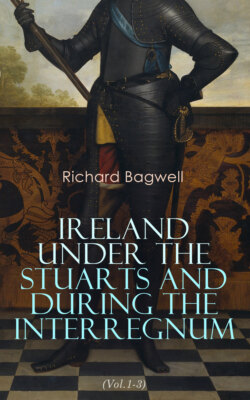Читать книгу Ireland under the Stuarts and During the Interregnum (Vol.1-3) - Bagwell Richard - Страница 6
FOOTNOTES:
Оглавление[1] Lord Deputy and Council to the Privy Council, April 6; Tyrone to Cecil, April 7; submission of Tyrone, April 8; Godolphin to Carew, April 19. Farmer’s chronicle of this reign begins at p. 40 of MS. Harl. 3544 with a panegyric on ‘Elizabeth the virgin Queen and flower of Christendom that hath been feared for love and honoured for virtue, beloved of her subjects and feared of her enemies, magnified among princes and famozed through the world for justice and equity.’ Since these chapters were written Farmer’s book has been printed by Mr. Litton Falkiner in vol. xxii. of the English Historical Review.
[2] In Cambrensis Eversus, published in 1662, John Lynch says ‘the Irish no longer wished to resist James (especially as they believed that he would embrace the Catholic religion), and submitted not unwillingly to his rule, as to one whom they knew to be of Irish royal blood,’ iii. 53. Lynch was a priest in 1622. Stephen Duff, Mayor of Drogheda, to the Lord Deputy and Council, April 13; Mountjoy to Cecil, April 19, 25 and 26; Francis Bryan, sovereign of Wexford, to Mountjoy, April 23. James VI. to Tyrone, December 22, 1597, in Lansdowne MSS. lxxxiv. Tyrone to James VI., April 1600 in the Elizabethan S.P. Scotland. Letters of Elizabeth and James, Camden Society, p. 141. Farmer’s Chronicle.
[3] Muster of the army, April 27; Lord Deputy and Council to the Privy Council, Mountjoy to Cecil, and Sir G. Carey to Cecil, May 4; Humphrey May to Cecil, May 5.
[4] Authorities last quoted; also Smith’s Waterford.
[5] Authorities last quoted; also Hogan’s Hibernia Ignatiana, p. 121.
[6] Hogan’s Hibernia Ignatiana, p. 118; Declaration of Edward Sotherne, June 16.
[7] Barnabas Kearney and David Wale to Aquaviva (Italian), July 7, 1603, from London, in Hibernia Ignatiana, p. 117. The burning of the service-book is mentioned in the official correspondence.
[8] Brief Declaration in Carew, 1603, No. 5; account written by Richard Boyle in Lismore Papers, 2nd series, i. 43. As clerk of the Munster Council Boyle was an eye-witness of all these proceedings. Moryson’s Itinerary, part ii. book iii. chap. 2.
[9] Brief Relation in Carew, 1603, No. 5; Irish State Papers calendared from April 20 to May 14; Lismore Papers, 2nd series, i. 43–73; Mountjoy to the Mayor of Cork, May 4, in Cox, p. 7. The full account in Smith’s Cork is mainly founded on the Lismore collection. Lady Carew’s letter of May 5, 1603, among the State Papers and Lady Boyle’s of March 18, 1609, in the Lismore Papers are both printed verbatim, and are interesting to compare as specimens of ladies’ composition.
[10] Farmer’s Chronicle in MS. Harl. 3544. Farmer was a surgeon.
[11] Authorities last quoted.
[12] Apsley’s account in Lismore Papers, 2nd series, i. 66.
[13] Notices of Meade in the Calendars of State Papers, Ireland, especially No. 355 of 1611, where his tract is entered as among the Cotton MSS. There is another copy in the Bodleian, Laudian MSS. Misc. 612, f. 143. The proceedings at Meade’s trial are calendared under 1603, No. 184.
[14] Davies to Cecil, December 1, 1603; proclamations calendared at October 11 and December 3.
[15] Le Case de Mixt Moneys, Trin. 2 Jacobi in Davies’ Reports, 1628; State of the Irish coin, calendared at June 12, 1606; Lord Deputy Chichester and Council to the Privy Council, calendared at March 2, 1607.
[16] Chichester was sworn in February 3, 1604–5.
